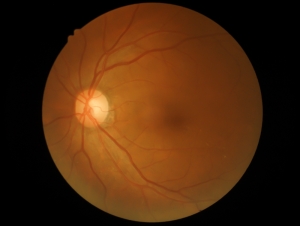Introduction
Any condition where clots can form and enter the arteries that supply the eye has the potential to close off the retinal artery.
This can be due to blood clots that grow on heart valves and then break off as in a patient with endocarditis. It can also come from fat emboli or from thrombosis as a result of arteriosclerotic changes in the carotid artery of an older person.
One serious complication of temporal arteritis, a complication associated with the rheumatological condition “polymyalgia rheumatica”, is sudden blindness from central retinal artery occlusion. Here is a site that shows pictures of fundoscopy findings.
Signs and symptoms
With central retinal artery occlusion blindness occurs suddenly on one eye. This is painless.
When the physician checks the affected eye for the pupillary light reflex (light should normally make the pupil smaller), there would be a poor or no such reflex. On the other hand the pupil of the same affected eye may respond very quickly when the other eye is tested with light.
Diagnostic tests
Apart from pupillary reflexes and lack of vision there are other findings. In the first three days the eye specialist using fundoscopy can see a lighter colored area where there is no blood flow to the affected retina. At the same time there is a cherry-red spot in the “fovea”, the area of the retina where most of the daytime vision normally takes place.
Here is a link where this can be seen (pictures of fundoscopy findings). When you click on the images, they enlarge.
Treatment
Unless the treatment is promptly started within less than 6 hours, there is no hope to restore vision in the affected area. Treatment is directed at reducing the eye pressure (intraoccular pressure), identifying and attempting to resolve the clot and to treat any other eye disease or other underlying medical condition.
References:
1. The Merck Manual: Retinal eye disorders.
2. Ferri: Ferri’s Clinical Advisor: Instant Diagnosis and Treatment, 2004 ed., Copyright © 2004 Mosby, Inc.
3. Rakel: Conn’s Current Therapy 2004, 56th ed., Copyright © 2004 Elsevier







